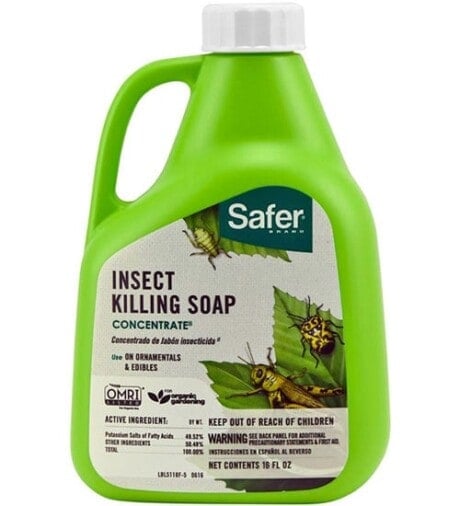Sawfly
Slug-like sawfly larvae feed on leaves and skeletonize them, leaving only a framework of veins. Here’s how to get rid of them using proven, organic methods.

Sawflies (Caliroa cerasi), also known as cherry or pear slugs, are widely distributed throughout the United States and Canada. They are a common pest of mountain ash, hawthorn, cotoneaster, cherry, plum and pear trees, and are occasionally found on quince and shadbush. High populations can defoliate entire trees.
Identification
Young larvae (1/2 inch long) are greenish-black, elongated, slim and slug-like, with very little evidence of legs. As the slugs grow, they become lighter colored. When fully mature, pear sawfly larvae resemble green-orange caterpillars. The adult (1/5 inch long) is a black and yellow, 4-winged non-stinging wasp (sawfly) that is rarely noticed.
Life Cycle
The winter is passed in the soil inside a cocoon. In the late spring, shortly after trees have come into full leaf, the adults emerge and deposit their eggs in the leaves. These hatch a week or more later, depending on temperature. Larval development is completed in less than a month and pupation takes place in the soil. Adults emerge during late July and August and lay eggs for the second generation of slugs. This generation usually causes the greatest amount of injury, especially on young trees which they may completely defoliate. When this second generation of larvae becomes fully grown, they go into the ground and remain as larvae until the following spring, when they pupate. There is usually only one generation per year, but there may be a partial second.
Sawfly Control
- Cultivate around trees and shrubs in the early spring and again in the fall to help reduce the overwintering population.
- Wash slugs off leaves with a strong jet of water from the Bug Blaster; larvae may also be sprayed with Safer® Soap.
- Apply food-grade Diatomaceous Earth for long-lasting protection. Made up of tiny fossilized aquatic organisms, that look like broken glass under the microscope, DE kills by scoring an insect’s outer layer as it crawls over the fine powder. Contains NO toxic poisons!
- AzaMax contains azadirachtin, the key insecticidal ingredient found in neem oil. This concentrated, organic insecticide offers multiple modes of action, making it virtually impossible for insect resistance to develop. Best of all, it’s non-toxic to honey bees and many other beneficial insects.
- Surround WP (kaolin clay) forms a protective barrier film, which acts as a broad spectrum crop protectant for preventing damage from insect pests.
- Many growers are reporting great success with Monterey® Garden Insect Spray (Spinosad). A relatively new insect killer, it can be applied to a large number of ornamental and garden plants. Best of all, it’s OMRI Listed for use in organic production.
- Least-toxic botanical insecticides should be used as a last resort. Derived from plants which have insecticidal properties, these natural pesticides have fewer harmful side effects than synthetic chemicals and break down more quickly in the environment.

















